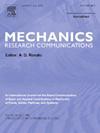Physics-informed extreme learning machine for rapid form-finding of frame-supported lightweight tensile membrane structures
IF 2.3
4区 工程技术
Q3 MECHANICS
引用次数: 0
Abstract
Tensile membrane structures (TMS) are one of the most in-demand types of structures these days owing to their aesthetic appeal, light-weight nature, ability to span large distances with very little supports, high material usage efficiency, etc. They are mostly used as roofing structures in stadiums, airports, parking lots, facades, etc. However, the design of such TMS is not trivial. The initial shape of the TMS is not known beforehand unlike other traditional structures like steel, masonry, etc. and hence, the designer requires a form finding framework to find the equilibrium shape of the TMS subjected to a particular combination of prestress and boundary constraints. Conventional mesh-based approaches, although very popular, are known to encounter serious convergence issues especially for non-minimal TMS related to choice of initial reference configuration, hyper-parameter selection, mesh-distortion, deviation of the Cauchy stress distribution on the form found surface, etc. Hence, an alternative mesh-less form finding method is proposed which is devoid of the aforementioned limitations of these customary form finding techniques. The modified Laplace equation is explored for form finding of TMS in this study by employing a new framework in the domain of scientific machine learning called the physics-informed extreme learning machine (PIELM). Initially a vanilla PIELM based framework is used for validation of the proposed form finding approach. However, this approach is seen to be a victim of the curse of dimensionality. Subsequently a modified algorithm based on PIELM is proposed and it is seen that for real life high dimensional TMS, the proposed method performs significantly better than Physics informed neural network (PINN) based form finding approach and a conventional mesh-based form finding approach in terms of computational efficiency. The advantage of this PIELM-based form finding in comparison to traditional physics-informed neural networks (PINNs) is in its extremely fast convergence, which can be highly beneficial for form finding design. Extensive form finding case studies show the overall reliability and computational efficiency of the proposed framework. Additionally, it is evident that the PIELM-based form finding framework can help provide a solution that is inherently devoid of the existing shortcomings associated with conventional mesh-based methodologies. A computational speedup of 50–100 times is also observed for a certain case study compared to traditional methods using the proposed scientific machine learning framework.
基于物理的极限学习机,用于框架支撑的轻质拉伸膜结构的快速成形
拉伸膜结构(TMS)是当今最受欢迎的结构类型之一,因为它们具有美观,重量轻,能够在很少的支撑下跨越长距离,材料使用效率高等特点。多用于体育场、机场、停车场、外墙等屋面结构。然而,这种经颅磁刺激的设计并不简单。与其他传统结构(如钢、砖石等)不同,TMS的初始形状事先是未知的,因此,设计师需要一个寻形框架来找到TMS在预应力和边界约束的特定组合下的平衡形状。传统的基于网格的方法虽然非常流行,但众所周知会遇到严重的收敛问题,特别是与初始参考结构的选择、超参数的选择、网格畸变、发现表面上的柯西应力分布的偏差等相关的非最小TMS。因此,提出了一种替代的无网格查找方法,该方法没有这些传统查找技术的上述限制。在本研究中,通过采用科学机器学习领域的新框架,即物理信息极端学习机(PIELM),探索了修正拉普拉斯方程的TMS寻形。最初,一个基于PIELM的框架被用于验证所提出的表单查找方法。然而,这种方法被认为是维度诅咒的受害者。随后提出了一种基于PIELM的改进算法,结果表明,对于现实生活中的高维TMS,该方法在计算效率方面明显优于基于物理通知神经网络(PINN)的寻形方法和传统的基于网格的寻形方法。与传统的物理信息神经网络(pinn)相比,这种基于pielm的查找表单的优势在于其极快的收敛速度,这对查找表单设计非常有益。广泛的形式查找案例研究表明了所提出框架的总体可靠性和计算效率。此外,很明显,基于pielm的表单查找框架可以帮助提供一种解决方案,这种解决方案本质上没有与传统的基于网格的方法相关的现有缺点。与使用所提出的科学机器学习框架的传统方法相比,在某个案例研究中也观察到计算速度提高了50-100倍。
本文章由计算机程序翻译,如有差异,请以英文原文为准。
求助全文
约1分钟内获得全文
求助全文
来源期刊
CiteScore
4.10
自引率
4.20%
发文量
114
审稿时长
9 months
期刊介绍:
Mechanics Research Communications publishes, as rapidly as possible, peer-reviewed manuscripts of high standards but restricted length. It aims to provide:
• a fast means of communication
• an exchange of ideas among workers in mechanics
• an effective method of bringing new results quickly to the public
• an informal vehicle for the discussion
• of ideas that may still be in the formative stages
The field of Mechanics will be understood to encompass the behavior of continua, fluids, solids, particles and their mixtures. Submissions must contain a strong, novel contribution to the field of mechanics, and ideally should be focused on current issues in the field involving theoretical, experimental and/or applied research, preferably within the broad expertise encompassed by the Board of Associate Editors. Deviations from these areas should be discussed in advance with the Editor-in-Chief.

 求助内容:
求助内容: 应助结果提醒方式:
应助结果提醒方式:


